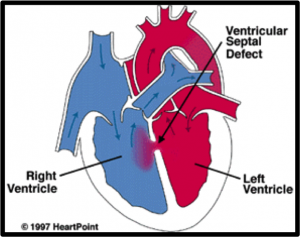
Subvalvular Aortic Stenosis (SAS)
Canine subvalvular aortic stenosis (SAS) is an abnormal, congenital heart murmur caused by subaortic stenosis (SAS). It is a common congenital heart defect that consists of abnormal tissue located just below the aortic valve that creates an obstruction the heart has to overcome to pump blood out to the body. As a result, the heart muscle can become thickened. The blood is pumped at a higher speed and pressure across the stenosis into the aorta, creating a heart murmur.
This genetic trait is polygenic. An animal might have the genes for SAS, yet have no actual sign of SAS. Also, an animal might have signs of subaortic stenosis, and yet offspring with SAS may not demonstrate clinical signs for a couple of generations. Any animal that has subaortic stenosis should not be bred because they can pass the defect on to future offspring.
In many cases, affected dogs do not show any signs. Aortic stenosis is often initially detected upon hearing a heart murmur during a routine physical examination by a veterinarian. SAS is diagnosed via echocardiogram with Doppler performed by a veterinary cardiologist. This allows visualization of the four heart chambers and valves as well as the anatomy of the subaortic area.
Puppies and adult dogs diagnosed with subaortic stenosis can suffer from heart failure and sudden death. If a dog with SAS develops heart failure, medications can be prescribed to alleviate the clinical signs (sudden/strong lethargicism, continuous heavy panting, rise in temperature etc.)

Ventricular Septal Defect (VSD)
VSD is a congenital defect in cats and dogs and can vary in location and size. Most defects are small enough to restrict significant shunting between ventricles, resulting in a high-pressure gradient and a loud-intensity, right-side murmur. Diagnosis can be made with echocardiography. Prognosis and treatment options depend on defect size, location, and severity of shunting. Development of pulmonary arterial hypertension is possible. Many affected animals require no treatment and have a good prognosis.
Preventing VSD requires removing affected dogs as well as their littermates and parents from the breeding pool. Otherwise, there is no known preventative approach.
